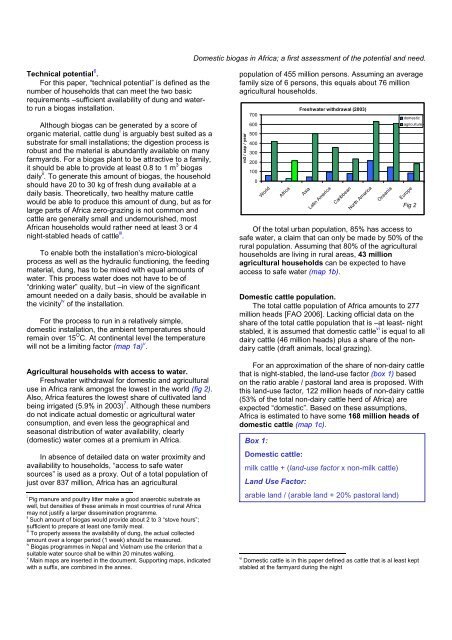Biogas for a better life - SNV Netherlands Development Organisation
Biogas for a better life - SNV Netherlands Development Organisation
Biogas for a better life - SNV Netherlands Development Organisation
You also want an ePaper? Increase the reach of your titles
YUMPU automatically turns print PDFs into web optimized ePapers that Google loves.
Technical potential 6 .<br />
For this paper, “technical potential” is defined as the<br />
number of households that can meet the two basic<br />
requirements –sufficient availability of dung and waterto<br />
run a biogas installation.<br />
Although biogas can be generated by a score of<br />
organic material, cattle dung i is arguably best suited as a<br />
substrate <strong>for</strong> small installations; the digestion process is<br />
robust and the material is abundantly available on many<br />
farmyards. For a biogas plant to be attractive to a family,<br />
it should be able to provide at least 0.8 to 1 m 3 biogas<br />
daily ii . To generate this amount of biogas, the household<br />
should have 20 to 30 kg of fresh dung available at a<br />
daily basis. Theoretically, two healthy mature cattle<br />
would be able to produce this amount of dung, but as <strong>for</strong><br />
large parts of Africa zero-grazing is not common and<br />
cattle are generally small and undernourished, most<br />
African households would rather need at least 3 or 4<br />
night-stabled heads of cattle iii .<br />
To enable both the installation’s micro-biological<br />
process as well as the hydraulic functioning, the feeding<br />
material, dung, has to be mixed with equal amounts of<br />
water. This process water does not have to be of<br />
“drinking water” quality, but –in view of the significant<br />
amount needed on a daily basis, should be available in<br />
the vicinity iv of the installation.<br />
For the process to run in a relatively simple,<br />
domestic installation, the ambient temperatures should<br />
remain over 15 O C. At continental level the temperature<br />
will not be a limiting factor (map 1a) v .<br />
Agricultural households with access to water.<br />
Freshwater withdrawal <strong>for</strong> domestic and agricultural<br />
use in Africa rank amongst the lowest in the world (fig 2).<br />
Also, Africa features the lowest share of cultivated land<br />
being irrigated (5.9% in 2003) 7 . Although these numbers<br />
do not indicate actual domestic or agricultural water<br />
consumption, and even less the geographical and<br />
seasonal distribution of water availability, clearly<br />
(domestic) water comes at a premium in Africa.<br />
In absence of detailed data on water proximity and<br />
availability to households, “access to safe water<br />
sources” is used as a proxy. Out of a total population of<br />
just over 837 million, Africa has an agricultural<br />
i Pig manure and poultry litter make a good anaerobic substrate as<br />
well, but densities of these animals in most countries of rural Africa<br />
may not justify a larger dissemination programme.<br />
ii Such amount of biogas would provide about 2 to 3 “stove hours”;<br />
sufficient to prepare at least one family meal.<br />
iii To properly assess the availability of dung, the actual collected<br />
amount over a longer period (1 week) should be measured.<br />
iv <strong>Biogas</strong> programmes in Nepal and Vietnam use the criterion that a<br />
suitable water source shall be within 20 minutes walking.<br />
v Main maps are inserted in the document. Supporting maps, indicated<br />
with a suffix, are combined in the annex.<br />
Domestic biogas in Africa; a first assessment of the potential and need.<br />
population of 455 million persons. Assuming an average<br />
family size of 6 persons, this equals about 76 million<br />
agricultural households.<br />
m3 / cap / year<br />
700<br />
600<br />
500<br />
400<br />
300<br />
200<br />
100<br />
0<br />
World<br />
Africa<br />
Freshwater withdrawal (2003)<br />
Asia<br />
Latin America<br />
Caribbean<br />
North America<br />
Oceania<br />
Of the total urban population, 85% has access to<br />
safe water, a claim that can only be made by 50% of the<br />
rural population. Assuming that 80% of the agricultural<br />
households are living in rural areas, 43 million<br />
agricultural households can be expected to have<br />
access to safe water (map 1b).<br />
Domestic cattle population.<br />
The total cattle population of Africa amounts to 277<br />
million heads [FAO 2006]. Lacking official data on the<br />
share of the total cattle population that is –at least- night<br />
stabled, it is assumed that domestic cattle vi is equal to all<br />
dairy cattle (46 million heads) plus a share of the nondairy<br />
cattle (draft animals, local grazing).<br />
For an approximation of the share of non-dairy cattle<br />
that is night-stabled, the land-use factor (box 1) based<br />
on the ratio arable / pastoral land area is proposed. With<br />
this land-use factor, 122 million heads of non-dairy cattle<br />
(53% of the total non-dairy cattle herd of Africa) are<br />
expected “domestic”. Based on these assumptions,<br />
Africa is estimated to have some 168 million heads of<br />
domestic cattle (map 1c).<br />
Box 1:<br />
Domestic cattle:<br />
milk cattle + (land-use factor x non-milk cattle)<br />
Land Use Factor:<br />
arable land / (arable land + 20% pastoral land)<br />
domestic<br />
agriculture<br />
Europe<br />
Fig 2<br />
vi Domestic cattle is in this paper defined as cattle that is al least kept<br />
stabled at the farmyard during the night

















